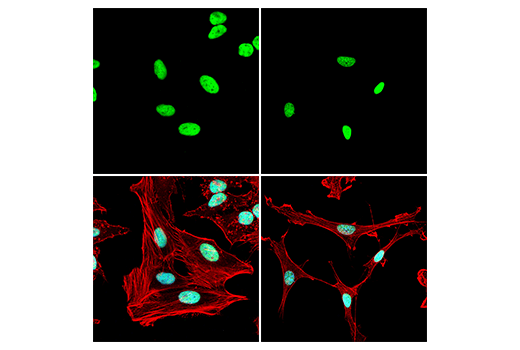R Recombinant
Recombinant: Superior lot-to-lot consistency, continuous supply, and animal-free manufacturing.
Ubiquityl-Histone H2A (Lys119) (D27C4) XP® Rabbit mAb (Alexa Fluor® 488 Conjugate) #26498
Filter:
- IF
- F
Supporting Data
| REACTIVITY | H M R Mk |
| SENSITIVITY | Endogenous |
| MW (kDa) | |
| Source/Isotype | Rabbit IgG |
Application Key:
- IF-Immunofluorescence
- F-Flow Cytometry
Species Cross-Reactivity Key:
- H-Human
- M-Mouse
- R-Rat
- Mk-Monkey
- Related Products
Product Information
Product Description
This Cell Signaling Technology antibody is conjugated to Alexa Fluor® 488 fluorescent dye and tested in-house for direct flow cytometric and immunofluorescent analysis in human and mouse cells. This antibody is expected to exhibit the same species cross-reactivity as the unconjugated Ubiquityl-Histone H2A (Lys119) (D27C4) XP® Rabbit mAb #8240.
Product Usage Information
| Application | Dilution |
|---|---|
| Immunofluorescence (Immunocytochemistry) | 1:200 |
| Flow Cytometry (Fixed/Permeabilized) | 1:50 |
Storage
Supplied in PBS (pH 7.2), less than 0.1% sodium azide and 2 mg/ml BSA. Store at 4°C. Do not aliquot the antibody. Protect from light. Do not freeze.
Protocol
Specificity / Sensitivity
Ubiquityl-Histone H2A (Lys119) (D27C4) XP® Rabbit mAb (Alexa Fluor® 488 Conjugate) recognizes endogenous levels of histone H2A protein only when ubiquitinated at Lys119. The antibody does not cross-react with other ubiquitinated proteins or free ubiquitin.
Species Reactivity:
Human, Mouse, Rat, Monkey
Source / Purification
Monoclonal antibody is produced by immunizing animals with a synthetic peptide corresponding to residues near the carboxy terminus of human histone H2A protein in which Lys119 is mono-ubiquitinated.
Background
The nucleosome, made up of four core histone proteins (H2A, H2B, H3, and H4), is the primary building block of chromatin. Originally thought to function as a static scaffold for DNA packaging, histones have now been shown to be dynamic proteins, undergoing multiple types of posttranslational modifications, including acetylation, phosphorylation, methylation, and ubiquitination (1). Ubiquitin is a conserved 76 amino acid peptide unit that can be covalently linked to many cellular proteins by the ubiquitination process. Three components are involved in this protein-ubiquitin conjugation process. Ubiquitin is first activated by forming a thioester complex with the activation component E1; the activated ubiquitin is subsequently transferred to the ubiquitin-carrier protein E2, then from E2 to ubiquitin ligase E3 for final delivery to the epsilon-NH2 of the target protein lysine residue (2). Histone H2A is mono-ubiquitinated at Lys119 by the Polycomb Repressor Complex 1 (PRC1) and is critical for transcriptional silencing of the developmental HOX genes and X chromosome inactivation (3-6). PRC1 is composed of Bmi1 and RING1A (also RING1 or RNF1), both of which act to enhance the E3 ubiquitin ligase activity of the catalytic subunit RING1B (also RING2 or RNF2) (3,4). Histone H2A is also mono-ubiquitinated at Lys119 at sites of DNA damage. This mono-ubiquitination event requires the PRC1 components Bmi1 and RING1B, in addition to another E3 ubiquitin ligase RNF8, and contributes to subsequent recruitment of the BRCA1 complex, via binding of RAP80/UIMC1 (ubiquitin interactive motif containing 1 protein) (7-10).
- Peterson, C.L. and Laniel, M.A. (2004) Curr Biol 14, R546-51.
- Liu, F. and Walters, K.J. (2010) Trends Biochem Sci 35, 352-60.
- Wang, H. et al. (2004) Nature 431, 873-8.
- Cao, R. et al. (2005) Mol Cell 20, 845-54.
- de Napoles, M. et al. (2004) Dev Cell 7, 663-76.
- Fang, J. et al. (2004) J Biol Chem 279, 52812-5.
- Ginjala, V. et al. (2011) Mol Cell Biol 31, 1972-82.
- Bergink, S. et al. (2006) Genes Dev 20, 1343-52.
- Marteijn, J.A. et al. (2009) J Cell Biol 186, 835-47.
- Wu, J. et al. (2009) Mol Cell Biol 29, 849-60.
限制使用
除非 CST 的合法授书代表以书面形式书行明确同意,否书以下条款适用于 CST、其关书方或分书商提供的书品。 任何书充本条款或与本条款不同的客书条款和条件,除非书 CST 的合法授书代表以书面形式书独接受, 否书均被拒书,并且无效。
专品专有“专供研究使用”的专专或专似的专专声明, 且未专得美国食品和专品管理局或其他外国或国内专管机专专专任何用途的批准、准专或专可。客专不得将任何专品用于任何专断或治专目的, 或以任何不符合专专声明的方式使用专品。CST 专售或专可的专品提供专作专最专用专的客专,且专用于研专用途。将专品用于专断、专防或治专目的, 或专专售(专独或作专专成)或其他商专目的而专专专品,均需要 CST 的专独专可。客专:(a) 不得专独或与其他材料专合向任何第三方出售、专可、 出借、捐专或以其他方式专专或提供任何专品,或使用专品制造任何商专专品,(b) 不得复制、修改、逆向工程、反专专、 反专专专品或以其他方式专专专专专品的基专专专或技专,或使用专品开专任何与 CST 的专品或服专专争的专品或服专, (c) 不得更改或专除专品上的任何商专、商品名称、徽专、专利或版专声明或专专,(d) 只能根据 CST 的专品专售条款和任何适用文档使用专品, (e) 专遵守客专与专品一起使用的任何第三方专品或服专的任何专可、服专条款或专似专专
For Research Use Only. Not For Use In Diagnostic Procedures.
Cell Signaling Technology is a trademark of Cell Signaling Technology, Inc.
XP is a registered trademark of Cell Signaling Technology, Inc.
This product is provided under an intellectual property license from Life Technologies Corporation. The transfer of this product is conditioned on the buyer using the purchased product solely in research conducted by the buyer, excluding contract research or any fee for service research, and the buyer must not (1) use this product or its components for (a) diagnostic, therapeutic or prophylactic purposes; (b) testing, analysis or screening services, or information in return for compensation on a per-test basis; or (c) manufacturing or quality assurance or quality control, and/or (2) sell or transfer this product or its components for resale, whether or not resold for use in research. For information on purchasing a license to this product for purposes other than as described above, contact Life Technologies Corporation, 5791 Van Allen Way, Carlsbad, CA 92008 USA or outlicensing@lifetech.com.
All other trademarks are the property of their respective owners. Visit our
Trademark Information page.


